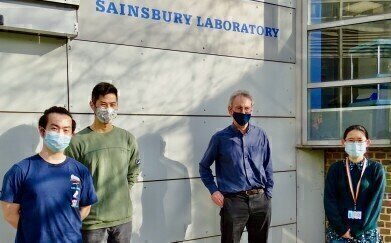-
 Professor Jones and team (Credit: TSL)
Professor Jones and team (Credit: TSL)
News & Views
Plant Cell Receptors join Forces to beat Bacterial Invasion
Mar 13 2021
In a study to understand better how plants defend themselves against bacterial pathogens, researchers at The Sainsbury Laboratory (TSL) have been able to unravel the roles played by two different cell receptors that normally work together to initiate an immune response.
Receptors at the cell surface detect pathogen-derived molecules that accumulate outside plant cells; this activates pattern-triggered immunity (PTI). PTI, however, is suppressed by pathogen-derived effector proteins, that are injected into host cells to enable pathogen growth. In response, the invading effectors can be detected by intracellular receptors in the plant which results in effector-triggered immunity (ETI). Until now, it has not been clear how the defence mechanisms activated by these two distinct perception mechanisms interact.
The scientists made their breakthrough by engineering the model plant Arabidopsis thaliana so that they could use a chemical to initiate the production of a recognised bacterial effector protein inside plant cells to activate ETI without PTI.
PhD student Bruno Pok Man Ngou, Professor Jonathan Jones and the rest of the team found that neither immune system alone is sufficient to provide resistance to the plant pathogenic bacterium Pseudomonas syringae. However, when both are activated together, the pathogen is thwarted, with ETI enhancing PTI and ETI enhancing PTI. In particular, detection of effectors by intracellular receptors greatly elevates the abundance of many of the key signalling components involved in activating plant defence upon pathogen detection by surface receptors. This replenishes their abundance after their attenuation by the pathogen's defence-suppression mechanisms.
These findings were corroborated by researchers from the Chinese Academy of Sciences who used a different but complementary approach. They used a modified version of A. thaliana with no functional surface receptors. These plants could therefore only mount ETI when challenged with the pathogen.
These discoveries strengthen the rationale for developing disease-resistant plants with several resistance genes to allow the perception of several effectors, while also reducing the need for chemical treatments.
Professor Jonathan Jones said “It's been a privilege to work with a wonderful team of co-authors on this important project. Ever since we distinguished defence activated by cell surface receptors and by intracellular receptors (PTI and ETI) 15 years ago, the questions of how these defences interact, and what ETI does in the absence of PTI, have remained open. These two papers constitute a major step towards integrating our understanding how and why these two components are both required for plant disease resistance.”
Bruno Pok Man Ngou, one of the lead researchers, said “Initially the inducible-effector system was generated to study ETI without interference from PTI. But what we saw at first didn't make sense because ETI alone didn’t seem to do much. Then we re-introduced PTI back into the system and suddenly everything became clear. Discussing unexpected data and testing new hypotheses with the team have been my favourite parts of this project. I think it is super cool that another research team arrived at the same conclusion with a different approach.”
This study “Mutual Potentiation of Plant Immunity by Cell-surface and Intracellular Receptors” appears in Nature.
More information online
Digital Edition
Lab Asia 31.2 April 2024
April 2024
In This Edition Chromatography Articles - Approaches to troubleshooting an SPE method for the analysis of oligonucleotides (pt i) - High-precision liquid flow processes demand full fluidic c...
View all digital editions
Events
Apr 28 2024 Montreal, Quebec, Canada
May 05 2024 Seville, Spain
InformEx Zone at CPhl North America
May 07 2024 Pennsylvania, PA, USA
May 14 2024 Oklahoma City, OK, USA
May 15 2024 Birmingham, UK

















